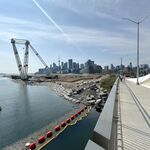Enjoyable article, though I'm not sure I agree with the concept of a rigid grid system as being the ultimate representation or facilitator of the city's potential for creativity and growth. I do agree that a grid facilitates flow, but in the end I feel that that flow has to be channeled and has to merge with other flowing forces, which is why I suspect that a grid punctuated by urban nexuses such as public squares and circles etc is extremely important, and that perhaps we should be considering more of them. As a case in point, the energy of Yonge Street, the Yonge/Dundas Intersection and the Eaton Centre seems to be merging in interesting ways in the public space at Dundas Square. On the other hand, although Queen Street West flows with creativity and potential there is little ability, aside from within the private realm, for that energy to coalesce in a similar way. Perhaps a 'Soho Square'-type space in the heart of the area would provide a similar sort of node or hub for this to happen.




